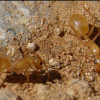I was hunting Pogonomyrmex queens (ID confirmation request coming up) and I found this. I think she might be a wasp? She was running around being attacked by argentines, doesn't look in too good shape. I definitely found lots of Pogonomyrmex queens though. Thanks for the help!
Location: Irvine, Ca
Date: 5/22/17
Habitat: Sandy creek bed
Length: 11mm
Coloration: red, picture fairly true to color
[img= ]
]
[img= ]
]
Edit: Instead of double posting ill just add to this.
Location: Irvine, Ca
Date: 5/22/17
Habitat: Sandy creek bed
Length: 12mm
Coloration: red, see first photo
I'm guessing these are P. californicus, hills type, single color. I'd be real happy for a confirmation though. Also, unlike desert bicolor, the hills type are not polygynous, right? Anyone have any experience with this? I caught 16 which realistically was way too many. ¯\_(ツ)_/¯


Edited by JasonD, May 22 2017 - 9:43 PM.


















